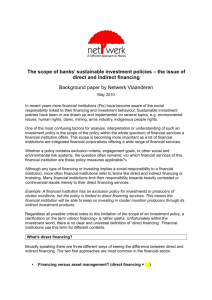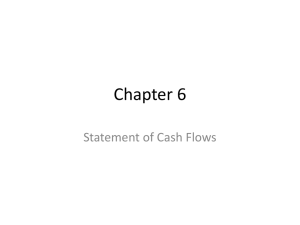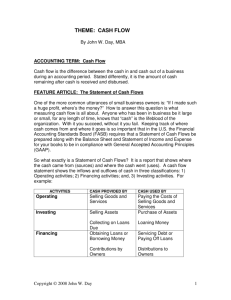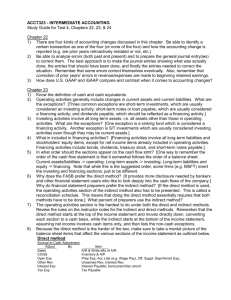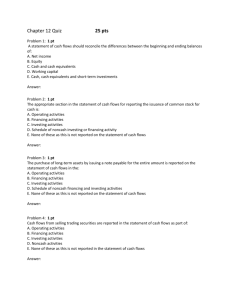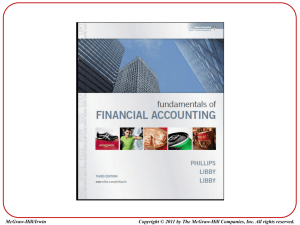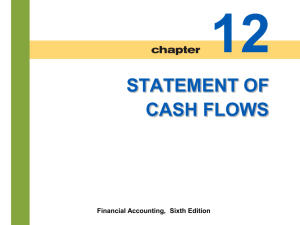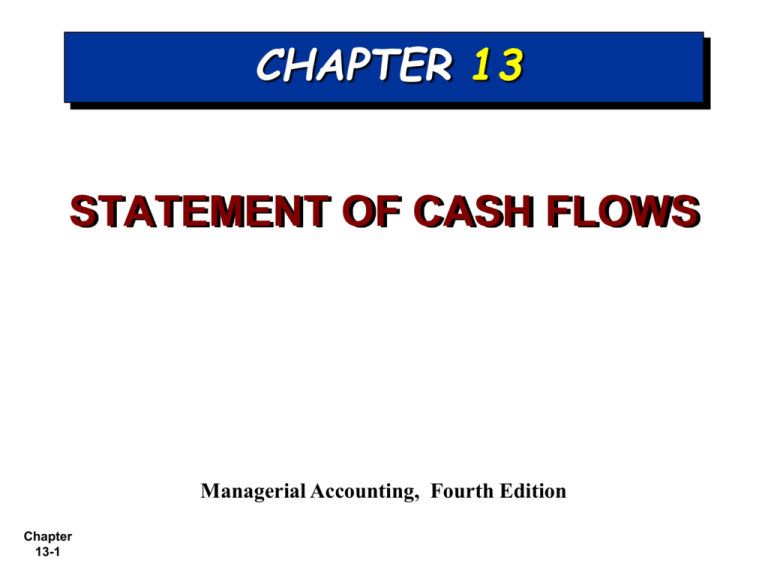
CHAPTER 13
STATEMENT OF CASH FLOWS
Managerial Accounting, Fourth Edition
Chapter
13-1
Usefulness of the Statement of Cash Flows
Provides information to help assess:
1. Entity’s ability to generate future cash flows.
2. Entity’s ability to pay dividends and obligations.
3. Reasons for difference between net income and net
cash provided (used) by operating activities.
4. Cash investing and financing transactions during
the period.
Chapter
13-2
LO 1 Indicate the usefulness of the statement of cash flows.
Classification of Cash Flows
Operating
Activities
Income
Statement
Items.
Chapter
13-3
Investing
Activities
Generally
Investments
and Long-Term
Assets.
Financing
Activities
Generally
Long-Term
Liability
and
Stockholders’
Equity .
LO 2 Distinguish among operating, investing, and financing activities.
Classification of Cash Flows
Classification of Typical Inflows and Outflows
Illustration 13-1
Operating activities - Income statement items
Cash inflows:
From sale of goods or services.
From interest received and dividends received.
Cash outflows:
To suppliers for inventory.
To employees for services.
To government for taxes.
To lenders for interest.
To others for expenses.
Chapter
13-4
LO 2 Distinguish among operating, investing, and financing activities.
Classification of Cash Flows
Classification of Typical Inflows and Outflows
Illustration 13-1
Investing activities - Changes in investments and longterm assets
Cash inflows:
From sale of property, plant, and equipment.
From sale of investments in debt or equity securities.
From collection of principal on loans to other entities.
Cash outflows:
To purchase property, plant, and equipment.
To purchase investments in debt or equity securities.
To make loans to other entities.
Chapter
13-5
LO 2 Distinguish among operating, investing, and financing activities.
Classification of Cash Flows
Classification of Typical Inflows and Outflows
Illustration 13-1
Financing activities - Changes in long-term liabilities
and stockholders’ equity
Cash inflows:
From sale of common stock.
From issuance of long-term debt (bonds and notes).
Cash outflows:
To stockholders as dividends.
To redeem long-term debt or reacquire capital stock
(treasury stock).
Chapter
13-6
LO 2 Distinguish among operating, investing, and financing activities.
Brief Exercise 13-2
Classify each item as an operating, investing or
financing activity. Assume all items involve cash
unless there is information to the contrary.
A.
B.
C.
D.
E.
F.
Chapter
13-7
A. Purchase of equipment
B. Sale of Building
C. Redemption of Bonds
Depreciation
Payment of Dividends
Issuance of Capital stock
Brief Exercise 13-2
Classify each item as an operating, investing or
financing activity. Assume all items involve cash
unless there is information to the contrary.
A.
B.
C.
D.
E.
F.
Chapter
13-8
A. Purchase of equipment - INVESTING
B. Sale of Building - INVESTING
C. Redemption of Bonds - FINANCING
Depreciation - OPERATING
Payment of Dividends - FINANCING
Issuance of Capital stock - FINANCING
Do It! Review 13-1
Rapture Corporation had the following
transactions.
A. Issued $200,000 of bonds payable
B. Paid Utilities expense
C. Issued 500 shares of preferred stock for
$45,000
D. Sold land and a building for $250,000
E. Lent $30,000 to Dead End Corporation,
receiving Dead End’s 1 year 12% note
Classify each of these transactions by type of
Chapter cash flow activity
13-9
Do It! Review 13-1
Rapture Corporation had the following
transactions.
A. Issued $200,000 of bonds payable FINANCING
B. Paid Utilities expense - OPERATING
C. Issued 500 shares of preferred stock for
$45,000 - FINANCING
D. Sold land and a building for $250,000 INVESTING
E. Lent $30,000 to Dead End Corporation,
receiving Dead End’s 1 year 12% note INVESTING
Chapter
13-10
Classification of Cash Flows
Significant Noncash Activities
1. Issuance of common stock to purchase assets.
2. Conversion of bonds into common stock.
3. Issuance of debt to purchase assets.
4. Exchanges of plant assets.
Companies report these activities in either a separate
schedule at the bottom of the statement of cash flows
or in a separate note or supplementary schedule to the
financial statements.
Chapter
13-11
LO 2 Distinguish among operating, investing, and financing activities.
Format of the Statement of Cash Flows
Order of Presentation:
1.
Operating activities.
2.
Investing activities.
3.
Financing activities.
Direct Method
Indirect Method
The cash flows from operating activities section
always appears first, followed by the investing
and financing sections.
Chapter
13-12
LO 2 Distinguish among operating, investing, and financing activities.
Format of the Statement of Cash Flows
Illustration 13-2
Chapter
13-13
LO 2 Distinguish among operating, investing, and financing activities.
Preparing the Statement of Cash Flows
Three Sources of Information:
1. Comparative balance sheets
2. Current income statement
3. Additional information
Three Major Steps:
Chapter
13-14
Illustration 13-3
LO 3 Prepare a statement of cash flows using the indirect method.
Preparing the Statement of Cash Flows
Three Major Steps:
Chapter
13-15
Illustration 13-3
LO 3 Prepare a statement of cash flows using the indirect method.
Preparing the Statement of Cash Flows
Indirect and Direct Methods
Companies favor the indirect
method for two reasons:
1. It is easier and less costly
to prepare, and
2. It focuses on the
differences between net
income and net cash flow
from operating activities.
Chapter
13-16
LO 3 Prepare a statement of cash flows using the indirect method.
Preparing the Statement of Cash Flows –
Indirect Method
Step 1: Operating Activities
Determine net cash provided/used by operating
activities by converting net income from an accrual
basis to a cash basis.
Common adjustments to Net Income (Loss):
Add back non-cash expenses (depreciation and
amortization expense).
Deduct gains and add losses.
Changes in current assets and current liabilities.
Chapter
13-17
LO 3 Prepare a statement of cash flows using the indirect method.
Step 1: Operating Activities
Depreciation Expense
Although depreciation expense reduces net income, it
does not reduce cash. Depreciation is a noncash
charge. The company must add it back to net income.
Illustration 13-6
Chapter
13-18
LO 3 Prepare a statement of cash flows using the indirect method.
Operating Activities
Loss on Sale of Equipment
Because companies report as a source of cash in the
investing activities section the actual amount of cash
received from the sale:
Any loss on sale is added to net income in the
operating section.
Any gain on sale is deducted from net income in
the operating section.
Chapter
13-19
LO 3 Prepare a statement of cash flows using the indirect method.
Operating Activities
Loss on Sale of Equipment
Illustration 13-7
Chapter
13-20
LO 3 Prepare a statement of cash flows using the indirect method.
Operating Activities
Changes to Noncash Current Asset Accounts
When the Inventory balance increases, the cost of
merchandise purchased exceeds the cost of goods sold.
Merchandise Inventory
1/1/11
Balance
Purchases
12/31/11 Balance
10,000
155,000
Cost of goods sold
150,000
15,000
As a result, cost of goods sold does not reflect cash
payments made for merchandise. The company deducts
from net income this inventory increase.
Chapter
13-21
LO 3 Prepare a statement of cash flows using the indirect method.
Operating Activities
Changes to Noncash Current Asset Accounts
When the Accounts Receivable balance decreases, cash
receipts are higher than revenue earned under the
accrual basis.
Illustration 13-8
Therefore, the company adds to net income the amount
of the decrease in accounts receivable.
Chapter
13-22
LO 3 Prepare a statement of cash flows using the indirect method.
Operating Activities
Changes to Noncash Current Asset Accounts
When the Prepaid Expense balance increases, cash paid
for expenses is higher than expenses reported on an
accrual basis. The company deducts the increase from
net income to arrive at net cash provided by operating
activities.
If prepaid expenses decrease, reported expenses are
higher than the expenses paid. The company adds the
decrease to net income.
Chapter
13-23
LO 3 Prepare a statement of cash flows using the indirect method.
Operating Activities
Changes to Noncash Current Asset Accounts
Illustration 13-9
Chapter
13-24
LO 3 Prepare a statement of cash flows using the indirect method.
Operating Activities
Changes to Noncash Current Liability Accounts
When Accounts Payable increases, this means the
company received more in goods than it actually paid for.
The increase is added to net income to determine net
cash provided by operating activities.
When Income Tax Payable decreases, this means the
income tax expense reported on the income statement
was less than the amount of taxes paid during the period.
The decrease is subtracted from net income to
determine net cash provided by operating activities.
Chapter
13-25
LO 3 Prepare a statement of cash flows using the indirect method.
Operating Activities
Changes to Noncash Current Liability Accounts
Illustration 13-10
Chapter
13-26
LO 3 Prepare a statement of cash flows using the indirect method.
Operating Activities
Summary of Conversion to Net
Cash Provided by Operating
Activities—Indirect Method
Illustration 13-11
Chapter
13-27
LO 3 Prepare a statement of cash flows using the indirect method.
Self Study Question #4
Which is an example of a cash flow from
operating Activity?
a.
b.
c.
d.
Chapter
13-28
Payment of cash to lenders for interest
Receipt of cash from the sale of capital
stock
Payment of cash dividends to the
company’s stockholders
None of the above
Self Study Question #9
Net Income is $132,000, accounts payable
increased $10,000 during the year, inventory
decreased $6,000 during the year and accounts
receivable increased $12,000 during the year.
Under the indirect method which is the net cash
provided by operating activities?
a.
b.
c.
d.
Chapter
13-29
$102,000
$112,000
$124,000
$136,000
Self Study Question # 11
The following data are available from Allen Clapp
Corporation
Net Income
$200,000
Depreciation Expense
40,000
Dividends Paid
60,000
Gain on sale of land
10,000
Decrease in accounts receivables
20,000
Decrease in accounts payables
30,000
Net Cash provided by operating activities is:
a. $160,000
b. $220,000
c. $240,000
Chapter
d. $280,000
13-30
Investing and Financing Activities
Partial Statement
Chapter
13-31
Illustration 13-13
LO 3 Prepare a statement of cash flows using the indirect method.
Step 2: Investing and Financing Activities
From the additional information, the company purchased land
of $110,000 by issuing long-term bonds. This is a significant
noncash investing and financing activity that merits disclosure
in a separate schedule.
Land
1/1/11
Balance
Issued bonds
12/31/11 Balance
20,000
110,000
130,000
Bonds Payable
1/1/11
Chapter
13-32
Balance
For land
20,000
110,000
12/31/11 Balance
130,000
LO 3 Prepare a statement of cash flows using the indirect method.
Investing and Financing Activities
From the additional information, the company acquired
an office building for $120,000 cash. This is a cash
outflow reported in the investing section.
Building
1/1/11
Balance
40,000
Office building 120,000
12/31/11 Balance
Chapter
13-33
160,000
LO 3 Prepare a statement of cash flows using the indirect method.
Investing and Financing Activities
Partial statement
Chapter
13-34
Illustration 13-13
LO 3 Prepare a statement of cash flows using the indirect method.
Investing and Financing Activities
The additional information explains that the equipment
increase resulted from two transactions: (1) a purchase of
equipment of $25,000, and (2) the sale for $4,000 of
equipment costing $8,000.
Journal
Entry
Chapter
13-35
Cash
Accumulated depreciation
Loss on sale of equipment
Equipment
4,000
1,000
3,000
8,000
LO 3 Prepare a statement of cash flows using the indirect method.
Statement
of Cash
Flows
Indirect
Method
Illustration 13-13
Chapter
13-36
LO 3 Prepare a statement of cash flows using the indirect method.
Investing and Financing Activities
The additional information notes that the increase in
common stock resulted from the issuance of new shares.
Common Stock
1/1/11
Balance
Shares sold
12/31/11 Balance
Chapter
13-37
50,000
20,000
70,000
LO 3 Prepare a statement of cash flows using the indirect method.
Investing and Financing Activities
Partial statement
Chapter
13-38
Illustration 13-13
LO 3 Prepare a statement of cash flows using the indirect method.
Investing and Financing Activities
Retained earnings increased $116,000 during the year. This
increase can be explained by two factors: (1) Net income of
$145,000 increased retained earnings. (2) Dividends of
$29,000 decreased retained earnings.
Retained Earnings
1/1/11
Dividends
29,000
Balance
Net income
12/31/11 Balance
Chapter
13-39
48,000
145,000
164,000
LO 3 Prepare a statement of cash flows using the indirect method.
Statement
of Cash
Flows
Indirect
Method
Illustration 13-13
Chapter
13-40
LO 3 Prepare a statement of cash flows using the indirect method.
Using Cash Flows to Evaluate a Company
Free Cash Flow
Free cash flow describes the cash remaining from
operations after adjustment for capital expenditures
and dividends.
Chapter
13-41
LO 4 Analyze the statement of cash flows.
ANY QUESTIONS?
Chapter
13-42
P13-1A
Transaction
You are provided with the following
transactions that took place during a
recent fiscal year.
Where
Reported on
Statement
Cash inflow,
Outflow or No
Effect
a. Recorded depreciation expense on the plant assets- O NE
b. Recorded and paid interest expense – O OUTFLOW
c. Recorded cash proceeds from a sale of plant assets I INFLOW
d. Acquired land by issuing common stock – NC NE
e. Paid a cash dividend to preferred stockholders – F OUTFLOW
f. Distributed a stock dividend to common stockholders – NC NE
g. Recorded cash sales – O INFLOW
h. Recorded sales on account – O NE
i. Purchased inventory for cash - O OUTFLOW
Chapter
j.13-43 Purchased inventory on account – O NE
P13-3A
The Income Statement of Dillon Company is presented
here:
Instructions:
Prepare the
Sales
$7,700,000
operating
Cost of Goods Sold
activities section
Beginning Inventory
$1,900,000
of the statement
Purchases
$4,400,000
of cash flows for
Cost Available for Sale
$6,300,000
the year ended
Ending Inventory
$1,400,000
th
Nov 30 2011,
Cost of Goods Sold
$4,900,000
for Dillon
Gross Profit
$2,800,000
Company using
Operating Expenses
$1,150,000
the indirect
Net Income
$1,650,000
method
Additional Information:
1. Accounts receivables increased $250,000 during the year and
inventory decreased $500,000
2. Prepaid expenses increased $150,000
3. Accounts Payables to suppliers of merchandise decreased
$340,000 during the year
4. Accrued expenses payables decreased $100,000 during the year
Chapter
5. Operating Expenses include depreciation expense of $90,000
13-44
Dillon Company
Statement of Cash Flows
November 30,2011
Net Income
$1,650,000
Adjustments to reconcile net income
to net cash provided by operating activities
Depreciation Expense
$ 90,000
Increase in A/R
(250,000)
Decrease in Inventory
500,000
Increase in Prepaid Expenses
(150,000)
Decrease in A/P
(340,000)
Decrease in Accrued Expenses Payable (100,000)
(250,000)
Net Cash Provided by Operating Activities
$1,400,000
Chapter
13-45
Cotte Company’s Income statement contained the condensed
information below:
P13-5A
COTTE COMPANY
Income Statement
For the Year Ended December 31, 2011
Revenues
$970,000
Operating expenses,
excluding depreciation
$624,000
Depreciation expense
60,000
Loss on Sale of Equipment
16,000
700,000
Income before Income Taxes
270,000
Income Tax Expense
40,000
Net Income
$230,000
Cotte’s Balance Sheet contained the comparative data at
December 31 shown below
Accounts receivable
Accounts Payable
Income taxes Payable
Chapter
13-46
2011
$75,000
41,000
11,000
2010
$60,000
28,000
7,000
Accounts payable pertain to operating expenses
P13-5A
Instructions: Prepare the operating
activities section of the statement of
cash flows using the indirect method.
Net Income
Depreciation expense
Increase in A/R
Increase in A/P
Increase in
Taxes Payable
Loss on
Sale of Equipment
Net Cash provided by
Operating activities:
Chapter
13-47
$230,000
60,000
(15,000)
13,000
4,000
16,000
78,000
$308,000
Copyright
“Copyright © 2010 John Wiley & Sons, Inc. All rights reserved.
Reproduction or translation of this work beyond that permitted
in Section 117 of the 1976 United States Copyright Act without
the express written permission of the copyright owner is
unlawful. Request for further information should be addressed
to the Permissions Department, John Wiley & Sons, Inc. The
purchaser may make back-up copies for his/her own use only
and not for distribution or resale. The Publisher assumes no
responsibility for errors, omissions, or damages, caused by the
use of these programs or from the use of the information
contained herein.”
Chapter
13-48

